Something very spectacular – which has never been registered in Belgian ornithology – happened in 2014! The most recent and up to date data mention at least 25 breeding pairs of Short-eared Owl in West Flanders! Probably a few breeding pairs in other Belgian provinces passed unnoticed. For instance in Henegouwen a photographer took pictures from a Short-eared Owl attacking a Marsh Harrier by the end of June… This indicates at least breeding behaviour of the Owl. So the real numbers of breeding birds in Belgium will probably even be slightly higher than 25 breeding pairs.
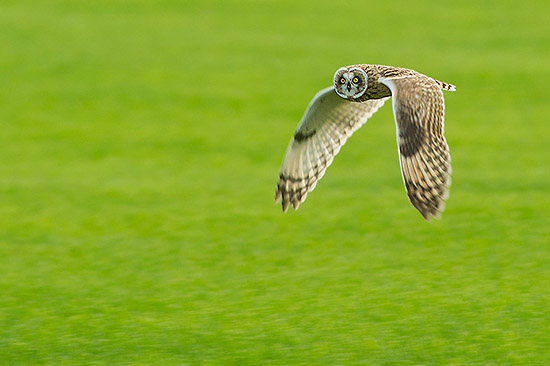
A truly exceptional situation, which has never been registered before in Belgium. Even before the general decline of Short-eared Owls in Western Europe, the species has always been a scarce and irregular breeding bird in Belgium, with the core of the breeding pairs usually found in the extensive brackish polder complexes and in the estuarine ecosystems, such as the Zwin and the polders of Uitkerke and Dudzele. Even during ‘the better owl years’, only a few birds effectively bred in these areas. In the large heath areas in Antwerp and Limburg, from time to time successful breeding was registered. Another more traditional breeding area of Short-eared Owls, are the ‘Hoge Venen’ or ‘Hautes Fagnes’, an extensive moor area with thousands of hectares of wet heath, bogs and small fens. But also in the Fagnes, there were never more than a few breeding pairs registered during one year. To summarize: during the past hundred years, there is no evidence that during one year there should have been more than a few breeding pairs of Short-eared Owl.
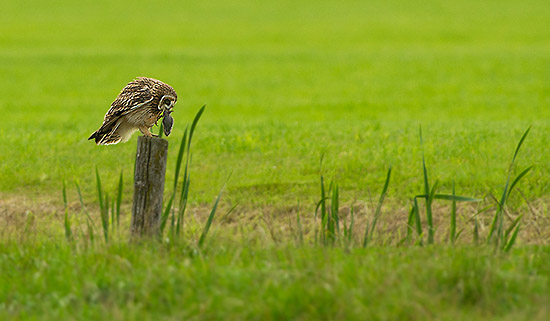
Under here, an image of the breeding habitat of a cluster of several Short-eared Owl pairs. I was able to witness the end of the spectacle, when the young birds had flown out by the begin of august (birds from late or second hatches). I spent four evenings observing and photographing the owls, which were still very active around dusk. A next image shows a Short-eared Owl in its typical breeding habitat, where they often roost during daytime in the brushwood or reed along the polder ditches.

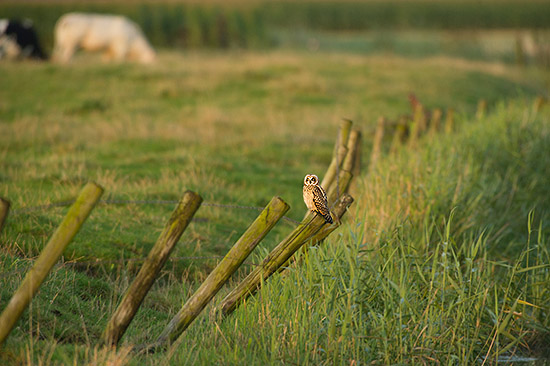
In 2014, the Short-eared Owls bred in three areas in the Northwest part of West Flanders, with a striking clustering of the pairs nesting very close to each other. It is particularly remarkable that none of these areas was one of the ‘classical wintering hotspots’ for Short-eared Owls, such as Uitkerke. Moreover, the winter of 2013-2014 wasn’t exceptional at all concerning the wintering numbers of Short-eared Owls. In Uitkerke, they were present with at least about five individuals in the core area and maybe a few more at close vicinity. But not a single Short-eared Owl bred in 2014 in this well surveyed area! As usual a few birds wintered in the polders and valleys more to the West, but again, these weren’t exceptional numbers at all. Fact is that the breeding population, which was located in the polders and the valleys more to the West, almost passed unnoticed! A local birder noticed during May – June, territorial activity and courtship behaviour in one of the three core breeding areas, and from then on things went fast. Half June the local birders were aware of the presence of probably more than five breeding pairs of Short-eared Owls, which was already breaking news for Belgium! Two weeks later more than 20 breeding pairs had been localised and during July a few more were found…
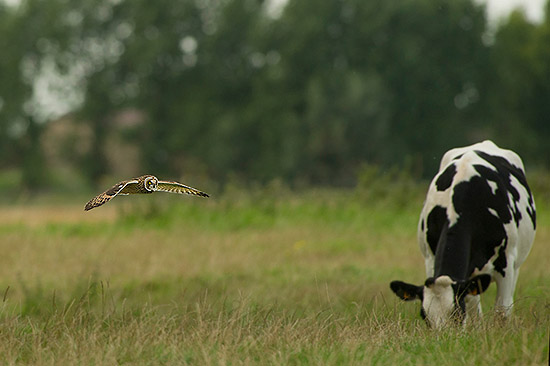
It remains a mystery why 2014 was so extremely successful for Short-eared Owl and many questions remain unsolved. Fact is that 2014 has been a really exceptional year, concerning peaking mice populations. But peaking mice populations aren’t that exceptional and this happens usually (at least) once every ten years. Moreover, the wintering numbers of Short-eared Owls weren’t that exceptional, at least as far as registered. Fact is that it is also possible that the wintering numbers of Short-eared Owls were higher than what was noticed by birders, because – for some unknown reason – many wintering Short-eared Owls are as crepuscular as Long-eared Owls. Uitkerke is quite an exceptional place, where the wintering birds always seem to start hunting quite early and often before sunset. In the Western valleys such as the IJzer and Handzame as well as in some other polder complexes, groups of Long-eared Owls winter in the same area as the Short-eared Owls. When the Short-eared Owls only fly out after dusk, they are barely distinguishable from the more common Long-eared Owls. The image under here, shows that - when not being able to observe well the characteristics, one could easily misstake a Short-eared Owl for a Long-eard Owl, as their behaviour can sometimes be very similar.
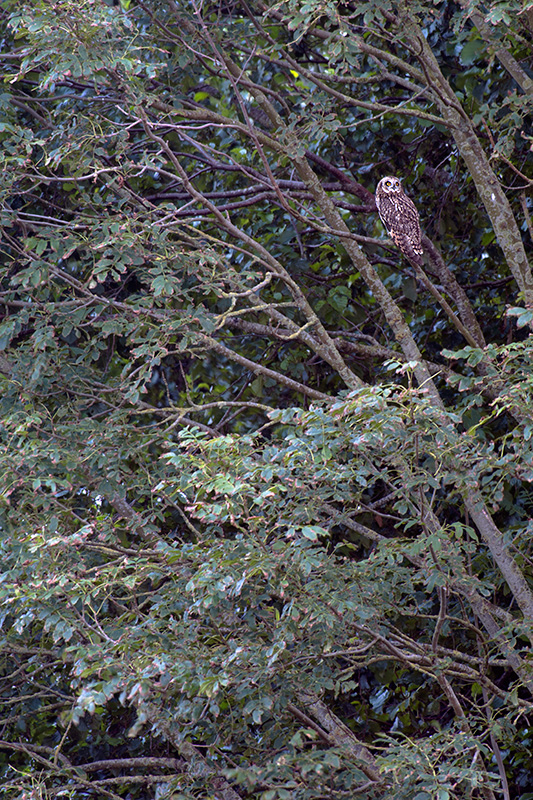
But let’s assume that the wintering numbers were not that high in 2013-2014. It is not unlikely that during May- June, our local wintering birds had found out by then that there was still plenty of food available and that conditions were very favourable to raise their young. By then they will have started to establish breeding territories and courtship probably took place. During May and June Short-eared Owls are often still migrating over Belgium and the local breeding birds might have attracted extra breeding pairs amongst migrating birds. But the exceptional mice population and perfect conditions for breeding still doesn’t explain why we never had another exceptional Short-eared Owl breeding year during the previous decades. One should expect that the conditions should have been at least a few times as favourable…
Finally it is worth mentioning that Short-eared Owl has an extremely nomadic character. Studies have pointed out that it is not exceptional that birds breed 4000 kilometres away from their previous breeding site!
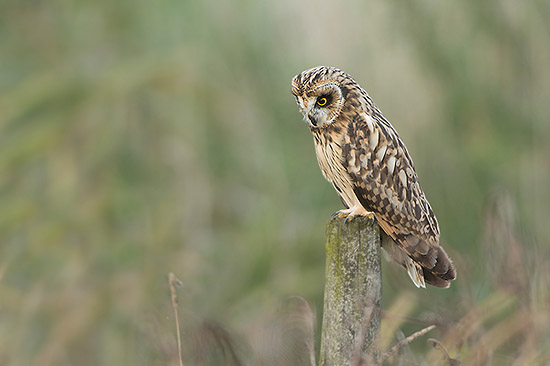
I'll mention under here three themes which could solve some part of the mystery why 2014 was so extremely successful.
It could be that during the past some breeding populations were unnoticed, especially if this took place in locations outside the traditional breeding grounds. Even in 2014 it was only thanks to the attention of one or two people that the exceptional situation was registered… Fact is that in the traditional breeding grounds such as the heaths and moors, which is a much poorer ecosystem, numbers of rodents will never be as high as in a richer valley ecosystems or in the polders. So it is not unlikely that during the past at least some breeding populations passed unnoticed.
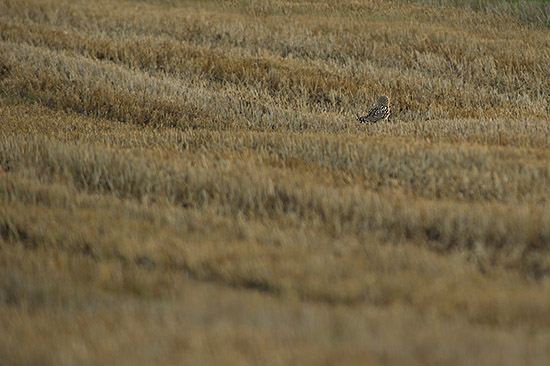
Another possibility is that we still don’t know well enough which are the more specific conditions which made the environment in 2014 so exceptionally favourable for Short-eared Owls. So far we don’t get much more specific then mentioning that it was an exceptional year for rodents in some areas… Which areas?, which types of rodents?, etc… We are still not able to give a clear answer to these questions. Maybe a combination of different factors on top of the mice and vole population really made 2014 exceptional concerning the breeding conditions for Short-eared Owls. In the area where I took my pictures a son of a local farmer told me that the period October- December 2014 was exceptionally wet. For this reason some of the farmland could not be prepared properly for the next season. In several areas the corn couldn’t be collected and had to be left rotting in some fields. This caused an explosion of Rats and Common Voles during the following months. Maybe some of these local parameters, combined with the availability of suitable classical breeding habitat with a network of polder ditches surrounded by reed, more extensive grasslands and brushwood, really made the conditions that exceptional in 2014.
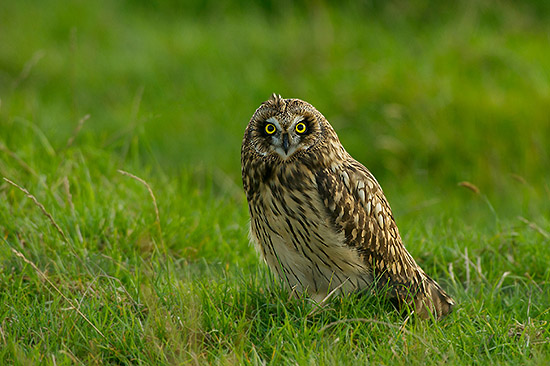
And finally: unfavourable conditions in breeding areas very far from here (probably far Eastern or Northern populations), might have caused these populations to migrate and roam in search for suitable breeding habitat. Some of them might have been searching in Western Europe for suitable habitat. In the Netherlands as well as in Germany locally exceptional breeding numbers have also been documented for 2014. A similar previously documented story is that severe draughts in the East European or Mediterranean countries can cause Corncrake and Spotted Crake populations to start roaming. In particular when during these years the conditions are favourable in the Lowlands, we can have unusual high breeding numbers of these species.
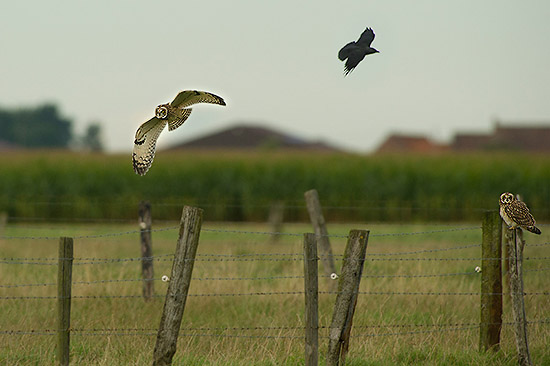
So it is clear that many of the questions concerning the Short-eared Owls remain unsolved. Hopefully in future, further data collecting and research will bring us closer to the answers.
Under here, some images from a hunting Owl (images 1 and 2), followed by an Owl who just caught a vole (image 3), and finally imges from the same Owl flying away with its prey.
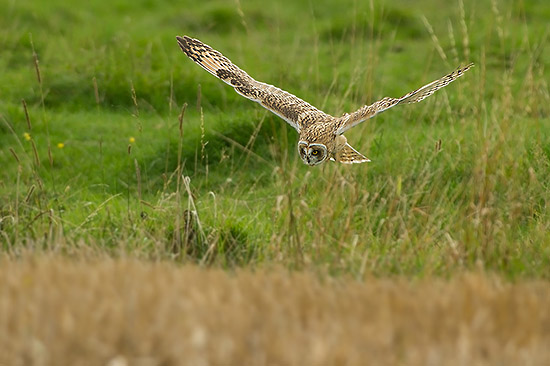


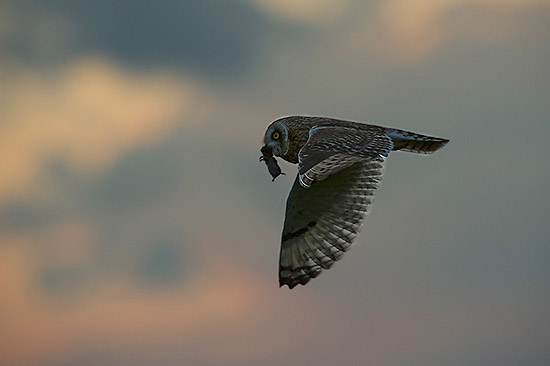

I'll end with an image of an Owl and the design of a typical black and white cow on the foreground. If you want to take a closer look at all the Short-eared Owl images or if you want to see the larger images, you can click here.

